Magnetized Saline Water Modulates Soil Salinization and Enhances Forage Productivity: Genotype-Specific Responses of Lotus corniculatus L.
Abstract
:1. Introduction
2. Materials and Methods
2.1. Geographic Location of the Study Area
2.2. Experimental Design and Treatment Arrangement
2.3. Irrigation System Setup
2.4. Magnetic Treatment of Saline Water
2.5. Fertilization
2.6. Variables Measured
2.6.1. Climatic Conditions
2.6.2. Physicochemical Characteristics of Soil and Water
2.6.3. Plant Growth and Yield
2.6.4. Data Analysis
3. Results
3.1. Climatic Conditions
3.2. Water and Soil Salinity
3.3. Plant GrowthT While During Winter the San Gabriel Variety Was the Most Affected, Going from 21 cm to 15.1 cm in MWT and NMWT, Respectively, Which Means 28.1% Lower Growth in Soils Irrigated with Water Without Magnetic Treatment (Figure 4)

3.4. Forage Yield
3.5. Principal Component Analysis
4. Discussion
5. Conclusions
Author Contributions
Funding
Data Availability Statement
Acknowledgments
Conflicts of Interest
References
- INECC-CGACC. México Ante el Cambio Climático. 2018. Available online: https://cambioclimatico.gob.mx/impactos-del-cambio-climatico-en-mexico/ (accessed on 11 August 2024).
- Karolina, F.; Agnieszka, W. The impact of extreme weather events as a consequence of climate change on the soil moisture and on the quality of the soil environment and agriculture—A review. Catena 2023, 231, 107378. [Google Scholar]
- Judit, D. From mystery to reality: Magnetized water to tackle the challenges of climate change and for cleaner agricultural production. J. Clean. Prod. 2023, 425, 139077. [Google Scholar]
- Azpilcueta-Pérez, M.E.; Pedroza-Sandoval, A.; Trejo-Calzada, R.; Sánchez-Cohen, I.; Jacobo-Salcedo, M.D.R. Chemical residuality in maize (Zea mays L.) fields irrigated with deep well water. Rev. Ecosist. Y Recur. Agropecu. 2018, 5, 111–117. [Google Scholar] [CrossRef]
- Macías, M.A.; Sevilla, G.Y.L. Naturaleza vulnerada. Cuatro décadas de agricultura industrializada de frutas y hortalizas en el sur de Jalisco, México (1980–2020). Rev. Cienc. Soc. Y Humanid. 2021, 8, 64–91. [Google Scholar] [CrossRef]
- EOS DATA ANALYTICS. Salinidad Del Suelo: Cómo Prevenirla y Reducirla. 2024. Available online: https://eos.com/es/blog/salinidad-del-suelo/ (accessed on 6 October 2024).
- Okba, S.K.; Mazrou, Y.; Mikhael, G.B.; Farag, M.E.H.; Alam-Eldein, S.M. Magnetized Water and Proline to Boost the Growth, Productivity and Fruit Quality of ‘Taifi’ Pomegranate Subjected to Deficit Irrigation in Saline Clay Soils of Semi-Arid Egypt. Horticulturae 2022, 8, 564. [Google Scholar] [CrossRef]
- Zúñiga, O.; Benavides, J.A.; Ospina-Salazar, D.I.; Jiménez, C.O.; Gutiérrez, M.A. Magnetic treatment of irrigation water and seeds in agriculture. Ing. Y Compet. 2016, 18, 217–232. [Google Scholar]
- Ali, Y.; Samaneh, R.; Kavakebian, F. Applications of Magnetic Water Technology in Farming and Agriculture Development: A Review of Recent Advances. Curr. World Environ. 2014, 9, 695–703. [Google Scholar] [CrossRef]
- Ahmed, A.M.; Al-Ogaidi, A.A.; Wayayok, A.; Rowshon, M.K.; Abdullah, A.F. The influence of magnetized water on soil water dynamics under drip irrigation systems. Agric. Water Manag. 2017, 180, 70–77. [Google Scholar] [CrossRef]
- Alfonso, I.; Daniel Pérez, G.C.; Pérez, M.I.; Silveira, P.E.A. Efecto del agua tratada magnéticamente sobre los procesos biológicos. Rev. Electrón. Vet. 2009, 10, 1–20. Available online: https://www.redalyc.org/articulo.oa?id=63611961010 (accessed on 10 July 2024).
- Alattar, E.; Radwan, E.; Elwasife, K. Improvement in growth of plants under the effect of magnetized water. AIMS Biophys. 2022, 9, 346–387. [Google Scholar] [CrossRef]
- Mamani, A.F. Aplicación de Agua Magnetizada para la Producción de Papa (Solanum tuberosum L.) en la Estación Experimental de Patacamaya; SIDALC: La Paz, Bolivia, 2017; Available online: https://repositorioslatinoamericanos.uchile.cl/handle/2250/1174059 (accessed on 15 November 2024).
- Yi, G.; Wang, Q.; Wang, K.; Zhang, J.; Wei, K.; Liu, Y. Spring irrigation with magnetized water affects soil water-salt distribution, emergence, growth, and photosynthetic characteristics of cotton seedlings in Southern Xinjiang, China. BMC Plant Biol. 2023, 23, 174. [Google Scholar] [CrossRef] [PubMed]
- Sifuentes-Rodríguez, N.S.; Pedroza-Sandoval, A.; Zegbe, J.A.; Trejo-Calzada, R. Indicadores de productividad y calidad de gel de sábila en condiciones de estrés salino. Rev. Fitotec. Mex. 2020, 43, 181–187. [Google Scholar] [CrossRef]
- Mota-Ituarte, M.; Pedroza-Sandoval, A.; Minjares-Fuentes, R.; Trejo-Calzada, R.; Zegbe, J.A.; Quezada-Rivera, J.J. Water deficit and salinity modify some morphometric, physiological, and productive attributes of Aloe vera (L.). Bot. Sci. 2023, 101, 463–475. [Google Scholar] [CrossRef]
- Fortis-H, M.; y Rhodante, A. Naturaleza y Extensión del Mercado de Agua en el Distrito de Riego 017 de la Comarca Lagunera, México. In Instituto Internacional de Manejo del Agua IWMI; Serie Latinoamericana No. 10; Instituto Internacional del Manejo del: Agua México, Mexico, 1999; p. 71. Available online: https://www.iwmi.org/Publications/Latin_American_Series/pdf/10.pdf (accessed on 5 June 2024).
- González-Espíndola, L.A.; Pedroza-Sandoval, A.; de los Santos, G.G.; Trejo-Calzada, R.; Álvarez-Vázquez, P.; María del Rosario Jacobo-Salcedo, M. Secondary Metabolites and Their Antioxidant Activity Enhance the Tolerance to Water Deficit on Clover Lotus corniculatus L. through Different Seasonal Times. Int. J. Plant Biol. 2024, 15, 175–186. [Google Scholar] [CrossRef]
- Pedroza-Sandoval, A.; Xolocotzi-Acoltzi, S.; Trejo-Calzada, R.; García-De los Santos, G.; Álvarez-Vázquez, P.; Arreola-Ávila, J.G. Leaf area index and forage productivity indicators of Lotus corniculatus L. at different soil moisture contents and seasons of the year. Rev. Mex. Cienc. Pecu. 2024, 15, 17–31. [Google Scholar]
- Morris, P.; Carter, E.B.; Hauck, B.; Lanot, A.; Allison, G. Responses of L. corniculatus to environmental change 3: The sensitivity of phenolic accumulation to growth temperature and light intensity and effects on tissue digestibility. Planta 2021, 253, 35. [Google Scholar] [CrossRef]
- Santacoloma-Varón, L.E.; Granados-Moreno, J.E.; Aguirre-Forero, S.E. Evaluación de variables agronómicas, calidad del forraje y contenido de taninos condensados de la leguminosa Lotus corniculatus en respuesta a biofertilizante y fertilización química en condiciones agroecológicas de trópico alto andino colombiano. Entramado 2017, 13, 222–233. [Google Scholar] [CrossRef]
- Pedroza-Parga, E.; Pedroza-Sandoval, A.; Velasquez-Valle, M.A.; Sánchez-Cohen, I.; Samaniego-Gaxiola, J.A. Effect of soil cover on the growth and productivity of buffel grass (Cenchrus ciliaris L.) in degraded soils of arid zones. Rev. Mex. Cienc. Pecu. 2022, 13, 866–878. [Google Scholar] [CrossRef]
- Rojas, C.J.M. Los Beneficios del Riego por Goteo en Tiempos de Sequía; CIMMYT. Desarrollo Estratégico: El Batan, Mexico, 2021; Available online: https://idp.cimmyt.org/los-beneficios-del-riego-por-goteo-en-tiempos-se-sequia/ (accessed on 7 July 2024).
- Medina-García, G.; Díaz-Padilla, G.; López-Hernández, J.; Ruiz-Corral, J.A.; Marín-Silva, M. Estadísticas Climatológicas Básicas del Estado de Durango. (Periodo 1961–2003); Libro Técnico № 1; Campo Experimental Valle del Guadiana. Centro de Investigación Regional Norte Centro-Instituto Nacional de Investigaciones Forestales, Agrícolas y Pecuarias: Durango, Mexico, 2005; p. 240. [Google Scholar]
- Bouyoucos, G.J. Hydrometer method improved for making particle size analysis of soils. Agron. J. 1962, 54, 464–465. [Google Scholar] [CrossRef]
- NOM-021-RECNAT-2000; Norma Oficial Mexicana. Que Establece las Especificaciones de Fertilidad, Salinidad y Clasificación de Suelos. Estudios, Muestreo y Análisis. 2002. DOF. 31/12/2002. Available online: https://www.ordenjuridico.gob.mx/Documentos/Federal/wo69255.pdf (accessed on 1 November 2024).
- Pedroza-Sandoval, A.; Trejo-Calzada, R.; Sánchez-Cohen, I.; Yáñez-Chávez, J.A.; Cruz-Martínez, A.; Figueroa-Viramontes, U. Water harvesting and soil water retention for forage production in degraded areas in arid lands of Mexico. In New Perspectives in Forage Crops; Ricardo, L.E., Leilson, R.B., Eds.; IntechOpen: London, UK, 2018; p. 210. [Google Scholar]
- Xolocotzi-Acoltzi, S.; Pedroza-Sandoval, A.; García-De los Santos, G.; Álvarez-Vázquez, P.; Gramillo-Ávila, I. Growth, Productivity, Yield Components and Seasonality of Different Genotypes of Forage Clover Lotus corniculatus L. under Varied Soil Moisture Contents. Plants 2024, 13, 1407. [Google Scholar] [CrossRef] [PubMed]
- Richards, L.A. Porous plate apparatus for measuring moisture retention and transmission by soil. Soil Sci. 1948, 66, 105–110. [Google Scholar] [CrossRef]
- Fallas, J. Análisis de Varianza Comparando Tres o Más Medias. 2012. Available online: https://www.ucipfg.com/Repositorio/MGAP/MGAP-05/BLOQUE-ACADEMICO/Unidad-2/complementarias/analisis_de_varianza_2012.pdf (accessed on 1 October 2024).
- Secretaria de Gobernación DOF. NORMA Oficial Mexicana NOM-127-SSA1-2021, Agua Para Uso y Consumo Humano. Límites Permisibles De La Calidad Del Agua. 2022. Available online: https://aneas.com.mx/wp-content/pdf/documentos-oficiales/11-lineamientos%20NOM-127-SSA1-2021.pdf (accessed on 8 December 2024).
- Nessrien, S.A.K. Evaluation of Magnetizing Irrigation Water Impacts on the Enhancement of Yield and Water Productivity for Some Crops. J. Agric. Sci. Technol. 2018, A8, 274–286. [Google Scholar]
- Zlotopolski, V. The Impact of magnetic water treatment on salt distribution in a large unsaturated soil column. Int. Soil Water Conserv. Res. 2017, 5, 253–257. [Google Scholar] [CrossRef]
- Hamza, A.H.; Sherif, M.A.; Wael, A.; Abd El-A, M.M. Impacts of Magnetic Field Treatment on Water Quality for Irrigation, Soil Properties and Maize Yield. J. Mod. Res. 2021, 3, 51–61. [Google Scholar] [CrossRef]
- Abdelghany, A.E.; Abdo, A.I.; Alashram, M.G.; Eltohamy, K.M.; Li, J.; Xiang, Y.; Zhang, F. Magnetized Saline Water Irrigation Enhances Soil Chemical and Physical Properties. Water 2022, 14, 4048. [Google Scholar] [CrossRef]
- Liu, X.; Wang, L.; Wei, Y.; Zhang, Z.; Zhu, H.; Kong, L.; Meng, S.; Song, C.; Wang, H.; Ma, F. Irrigation with magnetically treated saline water influences the growth and photosynthetic capability of Vitis vinifera L. seedlings. Sci. Hortic. 2020, 262, 109056. [Google Scholar] [CrossRef]
- Omran, W.M.; Mansour, M.M.F.; Fayez, K.A. Magnetized water improved germination, growth and tolerance to salinity of cereal crops. Int. J. Adv. Res. 2014, 2, 301–308. [Google Scholar]
- Kramina, T.E.; Meschersky, I.G.; Degtjareva, G.V.; Samigullin, T.H.; Belokon, Y.S.; Schanzer, I.A. Genetic variation in the Lotus corniculatus complex (Fabaceae) in northern Eurasia as inferred from nuclear microsatellites and plastid trnL-trnF sequences. Bot. J. Linn. Soc. 2018, 188, 87–116. [Google Scholar] [CrossRef]
- Napier, J.D.; Heckman, R.W.; Juenger, T.E. Gene-by-environment interactions in plants: Molecular mechanisms, environmental drivers, and adaptive plasticity. Plant Cell 2023, 35, 109–124. [Google Scholar] [CrossRef]
- Baye, T.M.; Abebe, T.; Wilke, R.A. Genotype-environment interactions and their translational implications. Pers. Med. 2011, 8, 59–70. [Google Scholar] [CrossRef]
- Zhou, B.; Yang, L.; Chen, X.; Ye, S.; Peng, Y.; Liang, C. Effect of magnetic water irrigation on the improvement of salinized soil and cotton growth in Xinjiang. Agric. Water Manag. 2021, 248, 106784. [Google Scholar] [CrossRef]
- Abedinpour, M.; Rohani, E. Effects of magnetized water application on soil and maize growth indices under different amounts of salt in the water. J. Water Reuse Desalin. 2017, 7, 319–325. [Google Scholar] [CrossRef]
- Wang, D.; Zhang, L.; Zhang, J.; Li, W.; Li, H.; Liang, Y.; Han, Y.; Luo, P.; Wang, Z. Effect of Magnetized BrackishWater Drip Irrigation on Water and Salt Transport Characteristics of Sandy Soil in Southern Xinjiang, China. Water 2023, 15, 577. [Google Scholar] [CrossRef]
- Ferreira, F.M.; do Amaral Santos de Carvalho Rocha, J.R.; Bhering, L.L.; Fernandes, F.D.; da Silva Lédo, F.J.; de Albuquerque Rangel, J.H.; Kopp, M.; Marinho, C.T.M.; Ribeiro da Silva, V.O.; Campolina, M.J. Optimal harvest number and genotypic evaluation of total dry biomass, stability, and adaptability of elephant grass clones for bioenergy purposes. Biomass Bioenergy 2021, 149, 106104. [Google Scholar] [CrossRef]
- Koudahe, K.; Allen, C.S.; Koffi, D. Critical review of the impact of cover crops on soil properties. Int. Soil Water Conserv. Res. 2022, 10, 343–354. [Google Scholar] [CrossRef]


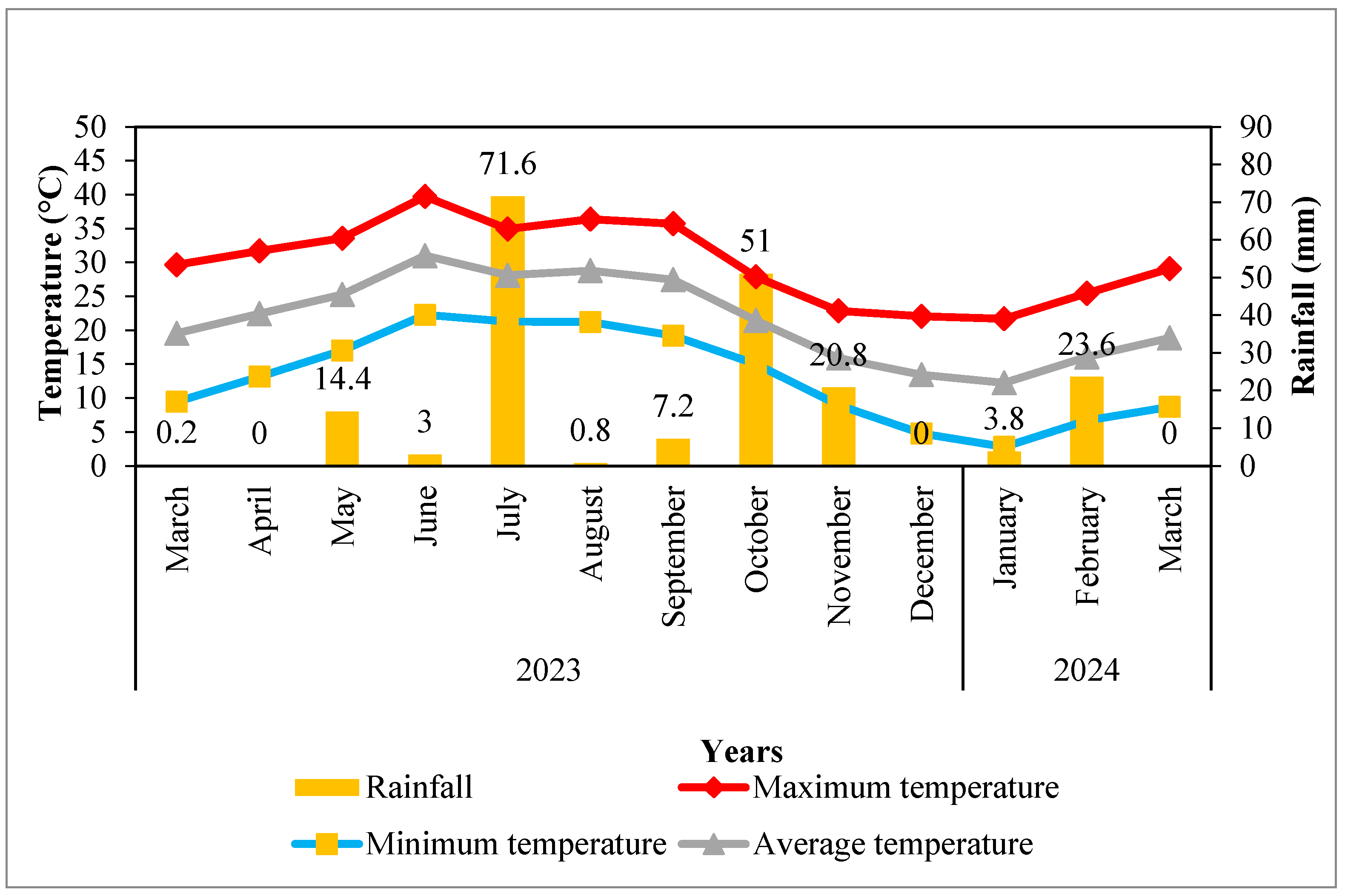

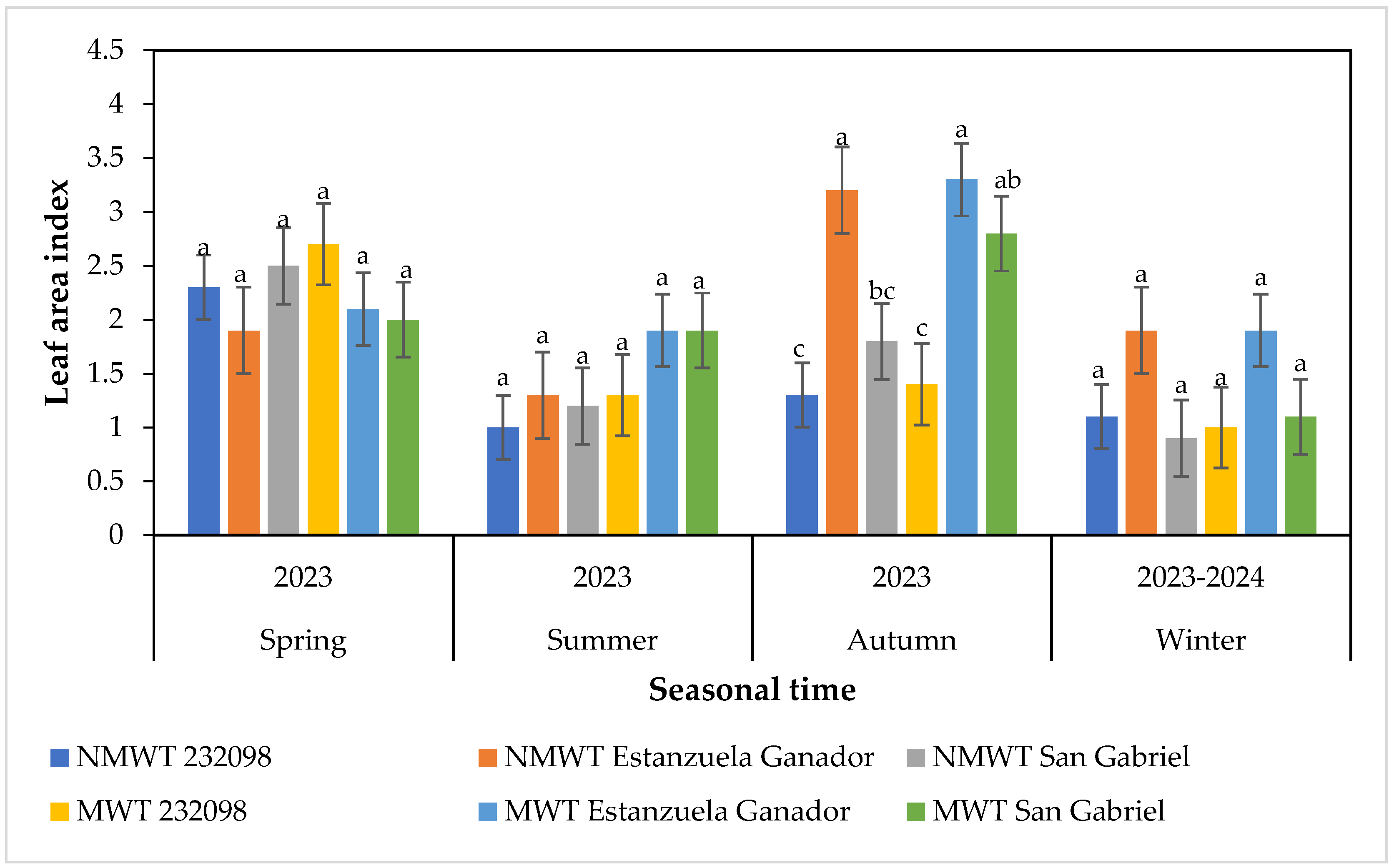

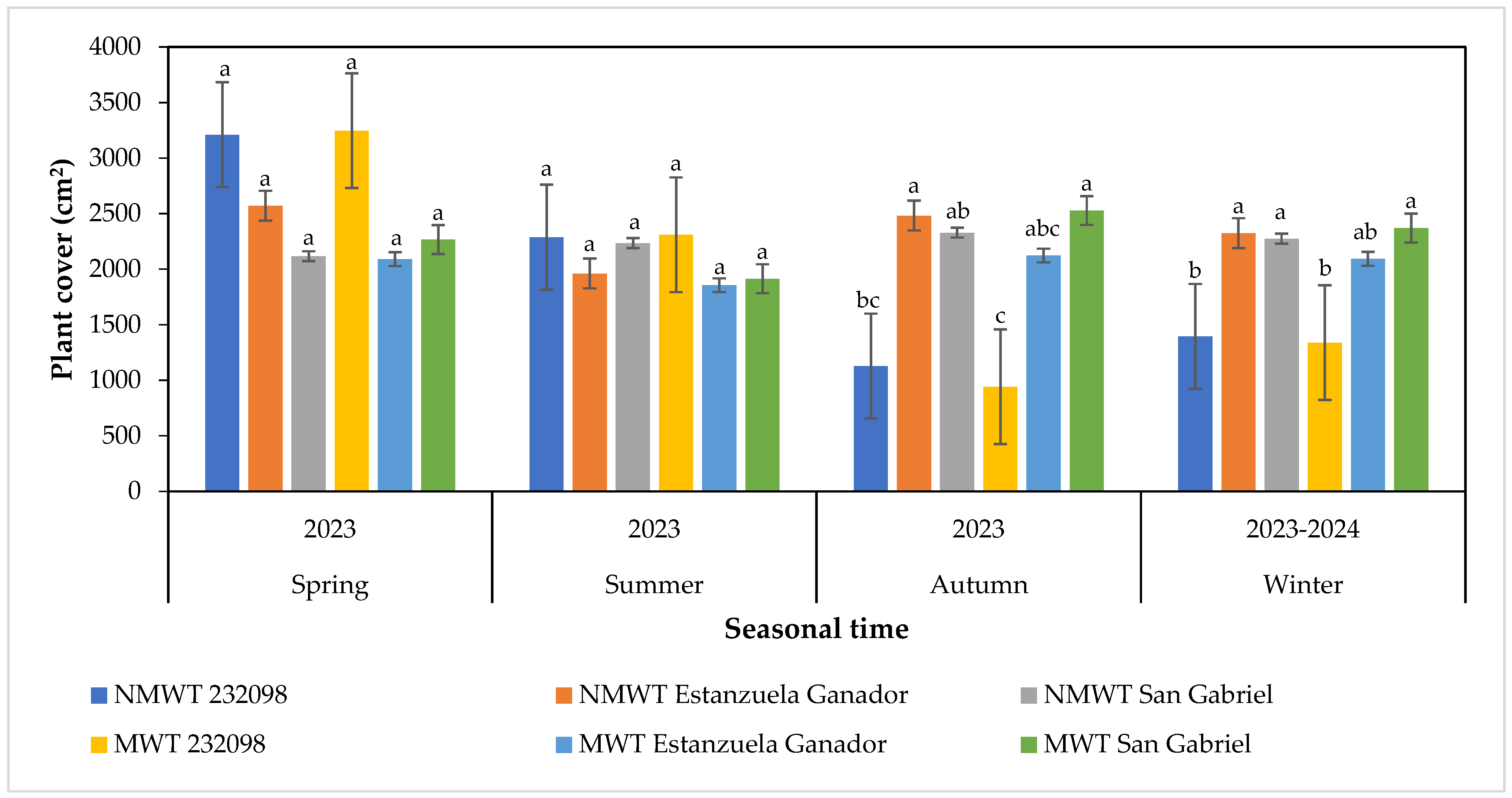
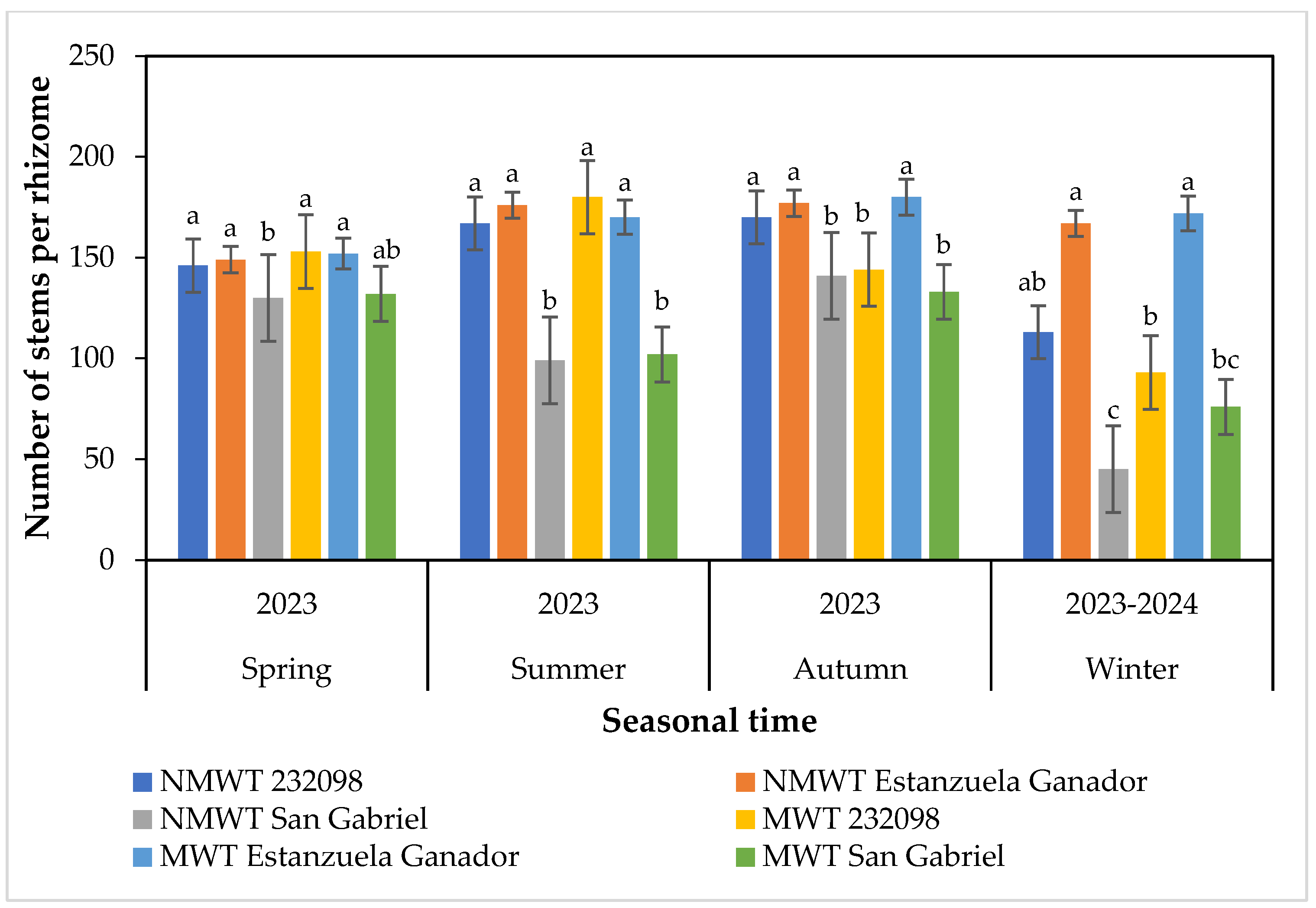
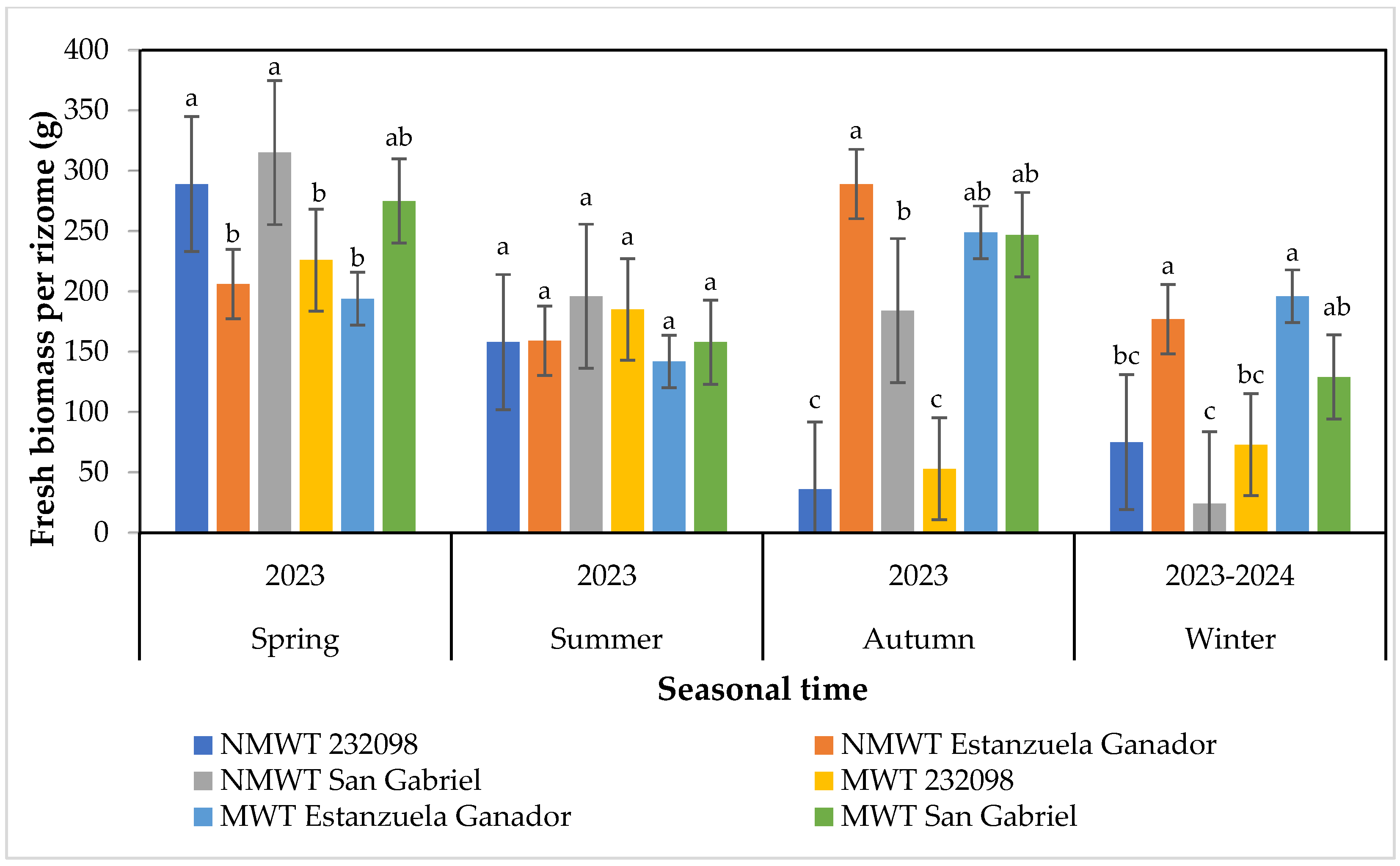

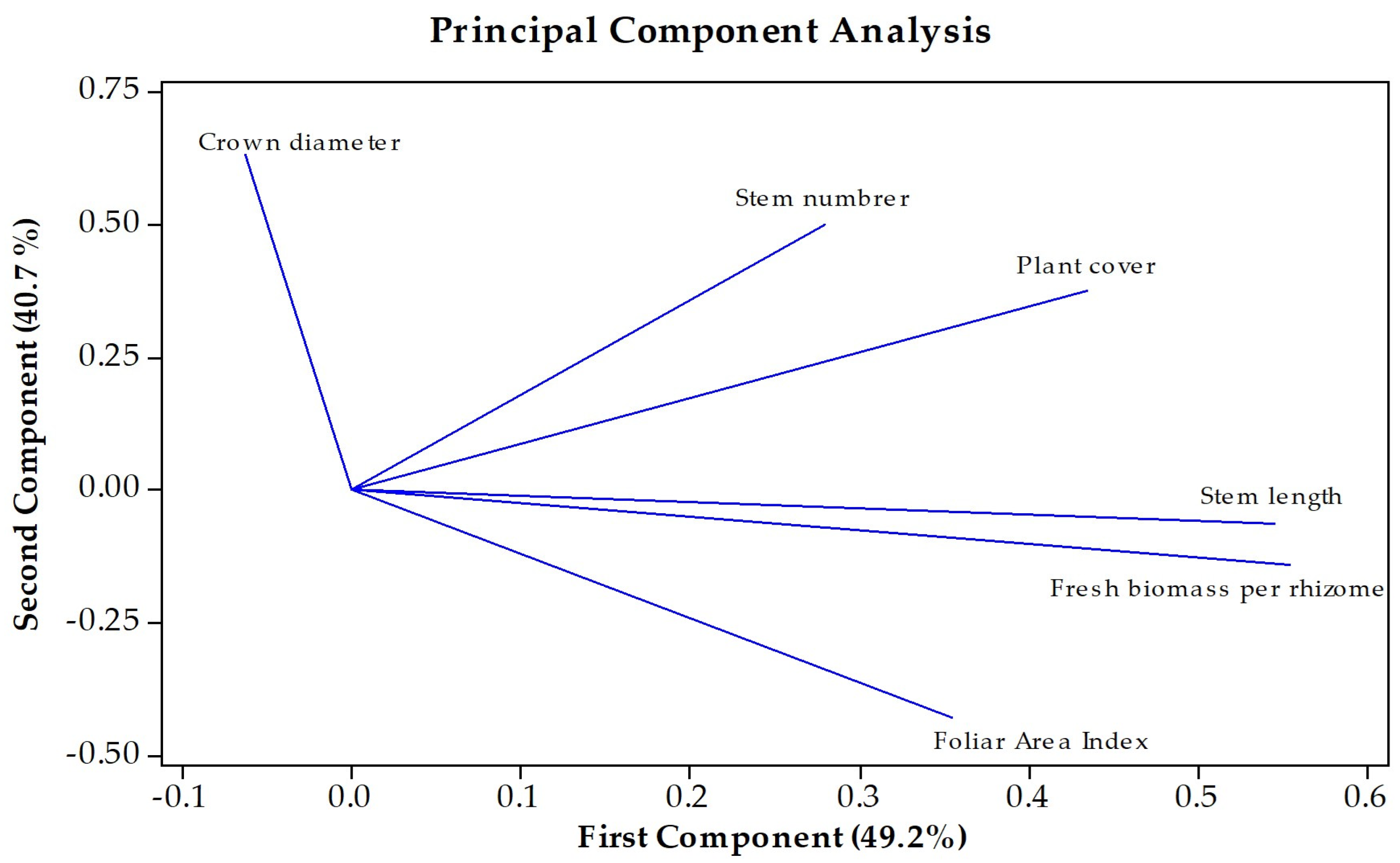

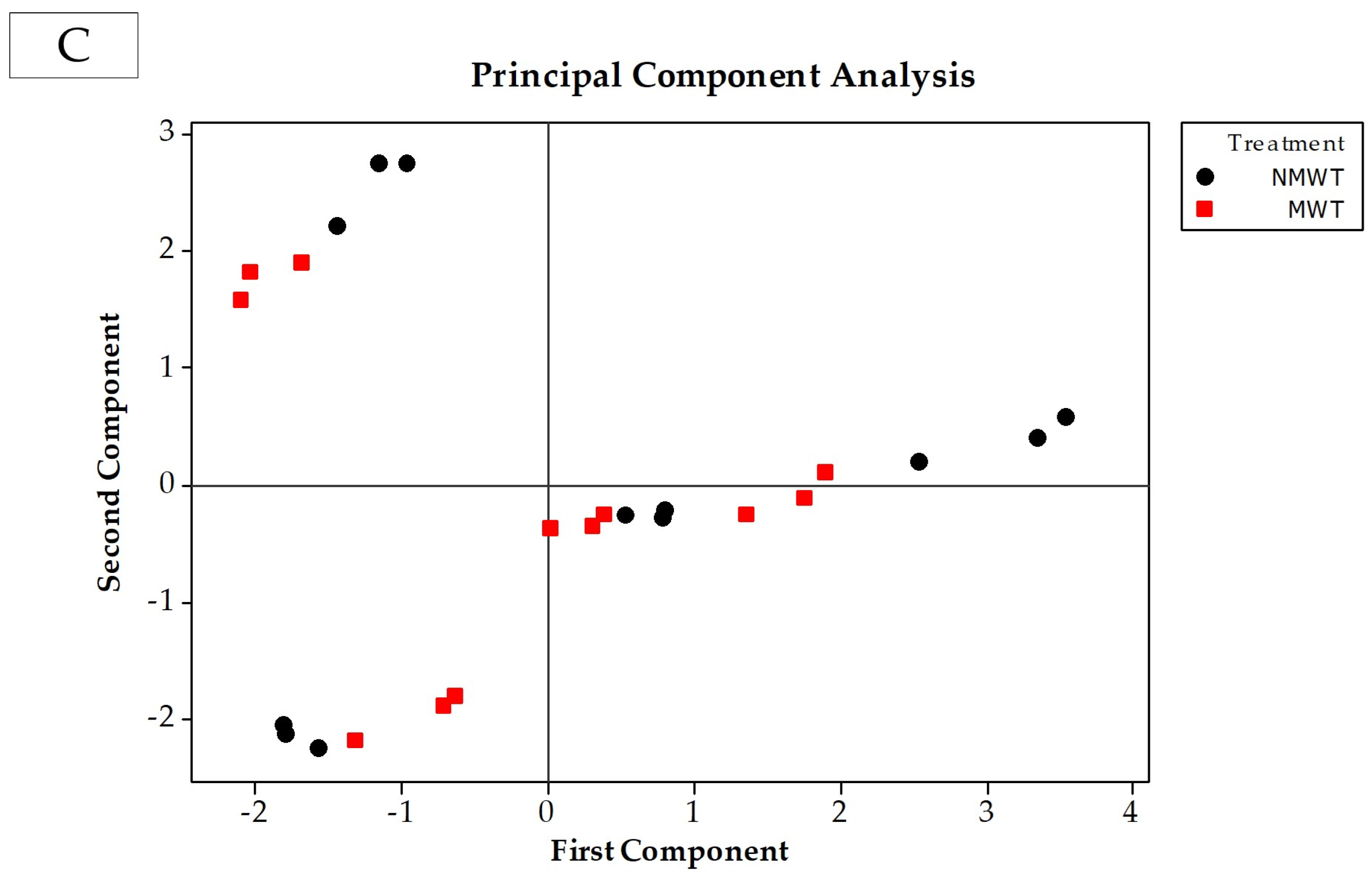
| Parameters | Non-Magnetized Water Treatment (NMWT) (20 July 2023) | Magnetized Water Treatment (MWT) (20 July 2023) |
|---|---|---|
| Hp | 7.16 | 7.29 |
| Electrical conductivity | 2.46 | 2.631 |
| Total dissolved solids (dS L−1) | 1574.4 | 1683.84 |
| Sodium adsorption ratio (SAR) (dS L−1) | 4.71 | 4.01 |
| Cations and anions | ||
| Calcium (meq L−1) | 12.61 | 14.50 |
| Magnesium (meq L−1) | 3.70 | 5.49 |
| Sodium (meq L−1) | 10.17 | 9.97 |
| Potassium (meq L−1) | 0.18 | 0.25 |
| Carbonates (meq L−1) | 0.00 | 0.00 |
| Bicarbonates (meq L−1) | 3.20 | 3.20 |
| Chlorides (meq L−1) | 5.04 | 5.32 |
| Sulfates (meq L−1) | 18.25 | 20.58 |
| Chemical Parameters * | Before Setting Up the Experiment ** (March 2023) | NMWT MWT (March 2024) | |
|---|---|---|---|
| pH | 8.1 | 8.0 | 8.1 |
| Electrical conductivity (EC) (dS m−1) | 4.14 | 7.2 | 5.8 |
| Total dissolved solids (ppm) | - | 5804 | 4636 |
| Sodium absorption ratio (SAR) | 2.58 | 8.4 | 6.2 |
| Sodium concentration (meq L−1) | 19.31 | 35.4 | 20.7 |
| Variable | Loading Values in Two Principal Components | |
|---|---|---|
| PC1 | PC2 | |
| Stem length | 0.544 | −0.062 |
| Crown diameter | −0.063 | 0.632- |
| Plant cover | 0.434 | 0.375 |
| Stem number | 0.280 | 0.501 |
| Foliar area index | 0.355 | −0.430 |
| Fresh biomass per rhizome | 0.554 | −0.140 |
Disclaimer/Publisher’s Note: The statements, opinions and data contained in all publications are solely those of the individual author(s) and contributor(s) and not of MDPI and/or the editor(s). MDPI and/or the editor(s) disclaim responsibility for any injury to people or property resulting from any ideas, methods, instructions or products referred to in the content. |
© 2025 by the authors. Licensee MDPI, Basel, Switzerland. This article is an open access article distributed under the terms and conditions of the Creative Commons Attribution (CC BY) license (https://creativecommons.org/licenses/by/4.0/).
Share and Cite
Pedroza-Sandoval, A.; González-Espíndola, L.Á.; Jacobo-Salcedo, M.d.R.; Gramillo-Ávila, I.; Miranda-Rojas, J.A. Magnetized Saline Water Modulates Soil Salinization and Enhances Forage Productivity: Genotype-Specific Responses of Lotus corniculatus L. Horticulturae 2025, 11, 428. https://doi.org/10.3390/horticulturae11040428
Pedroza-Sandoval A, González-Espíndola LÁ, Jacobo-Salcedo MdR, Gramillo-Ávila I, Miranda-Rojas JA. Magnetized Saline Water Modulates Soil Salinization and Enhances Forage Productivity: Genotype-Specific Responses of Lotus corniculatus L. Horticulturae. 2025; 11(4):428. https://doi.org/10.3390/horticulturae11040428
Chicago/Turabian StylePedroza-Sandoval, Aurelio, Luis Ángel González-Espíndola, María del Rosario Jacobo-Salcedo, Isaac Gramillo-Ávila, and José Antonio Miranda-Rojas. 2025. "Magnetized Saline Water Modulates Soil Salinization and Enhances Forage Productivity: Genotype-Specific Responses of Lotus corniculatus L." Horticulturae 11, no. 4: 428. https://doi.org/10.3390/horticulturae11040428
APA StylePedroza-Sandoval, A., González-Espíndola, L. Á., Jacobo-Salcedo, M. d. R., Gramillo-Ávila, I., & Miranda-Rojas, J. A. (2025). Magnetized Saline Water Modulates Soil Salinization and Enhances Forage Productivity: Genotype-Specific Responses of Lotus corniculatus L. Horticulturae, 11(4), 428. https://doi.org/10.3390/horticulturae11040428







